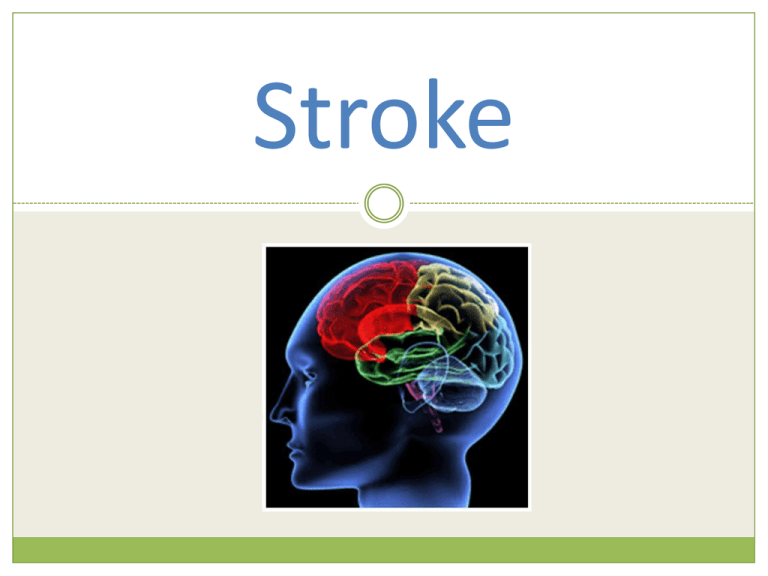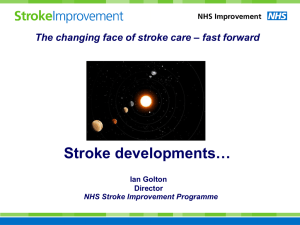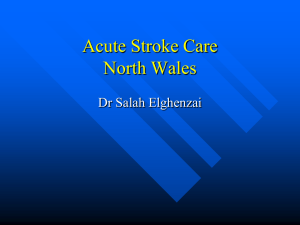
Stroke
Objectives
Define Stroke
Review Classifications, Statistics, and Risk Factors
Identify Early Warning Signs of a Stroke
Identify Primary Impairments
Identify Secondary Impairments
Recognize Hemispheric Differences
Understand Prognosis
Review Physical Therapy Interventions
Review Effective Interventions Based on Research
Stroke is the sudden loss of neurological function caused
by an interruption of the blood flow to the brain.
Ischemic Stroke: A clot
blocks or impairs blood
flow.
Hemorrhagic Stroke: Blood
vessels rupture and leak in
or around the brain.
Motor deficits are characterized by paralysis
(hemiplegia) or weakness (hemiparesis) typically
on the side of the body opposite the side of the
lesion.
I
Stroke Classification
Etiological
Thrombosis
Embolus
Hemorrhage
Management Categories
Transient Ischemic Attack
Minor Stroke
Major Stroke
Deteriorating Stroke
Young Stroke
Vascular Territory
Anterior Cerebral Artery Syndrome
Middle Cerebral Artery Syndrome
Internal Carotid Artery Syndrome
Posterior Cerebral Artery Syndrome
Lacunar Syndrome
Vertebrobasilar Artery Syndrome
Statistics of Stoke in 2008
4th Leading cause of death in the United States
1st Cause of long-term severe disability
700,000 strokes a year
5,400,000 estimated stroke survivors= 2.6% of population
18.8 billion costs for care in the United States
Incidence is 1.25 times greater for males than females
Highest Risk for African-Americans, American Indians and Alaska
Natives.
Lowest Risk for Asians and Native Hawaiian/Other Pacific
Islander
Incidence increases with age, doubling in the decade after 65
years of age.
Risk Factors
High Blood Pressure # 1 Risk Factor
Atrial Fibrillation
Diabetes
Family History of Stroke
High Cholesterol
Increasing Age, especially after age 55
Race
Birth control pills
Unhealthy lifestyle: Excessive drinking, smoking, illegal drug
use, eating too much salt or fat, and being overweight/obese.
Early Warning Signs of Stroke
“Time is Brain”
Sudden severe headache
Trouble walking
Sudden numbness or
Difficultly w/ swallowing
weakness on one side of the
body
Confusion, trouble speaking
or understanding
Vision problems in one or
both eyes
Lack of control over bladder
or bowels
Personality, mood or
emotional changes
Change in alertness
(sleepiness, convulsions,
coma)
Primary Impairments
M OTO R
S E N S O RY
VISION
L A N G UAG E , S P E EC H & S WA L LOW I NG
P O ST U R A L CO N T RO L & BA L A N C E
CO G N I T I O N
A F F EC T
B L A D D E R / B OW E L F U N C T I O N
Motor Impairments
Weakness – UE usually more affected than LE
Proximal muscles typically have more strength than distal muscles.
Stages of Motor Recovery
Tone – Flaccidity – usually lasting a few days or weeks, may persist in pts w/
lesions in primary motor cortex or cerebellum.
Spasticity – Present in 90% of pts, also contributes to abnormal synergy
patterns.
Abnormal Reflexes – vary according to stage in recovery
Altered Coordination – May cause ataxia, problems with timing and
sequencing of muscles, slow movements, or involuntary movements.
Altered Motor Programming- Ideational apraxia-inability to produce
movement on command. Ideomotor apraxia-pt can perform habitual task when
not commanded to.
Sensory Impairments
Frequently Impaired, but rarely absent.
Impaired Proprioception
Impaired Superficial Touch
Impaired Sensation of Pain
Numbness, dyesthesia, or hyperesthesia.
Hemisensory loss can contribute to unilateral neglect and injury.
Severe headache, neck or face pain may develop.
Thalamic pain – constant severe burning with intermittent sharp
pains may develop after a few weeks or months following a
stroke and may prevent the patient from participating in
rehab.
Vision Impairments
Homonymous Hemianopsia: A loss of vision in the nasal half of the visual
field of one eye and the temporal half of the visual field of the other eye.
(contributes to lack of awareness of hemiplegic side)
Visual Neglect: Pt can see all of the visual field but ignores objects on one
side.
Depth perception and spatial relationship problems.
Brain stem strokes may cause: diplopia, oscillopsia, or visual distortions.
Speech, Language and Swallowing Impairments
Aphasia – Impairment of language ability
Wernickes (Receptive) – Auditory comprehension is impaired, but
speech production is preserved.
Broca’s (Expressive) – Comprehension is good, but speech production is
labored or lost completely.
Global – Impairments in both production and comprehension of
language.
Dysarthria- Difficulty with controlling and coordinating muscles that are
used for speech.
Dysphagia – Difficulty in Swallowing.
Postural Control and Balance Impairments
Asymmetry in Sitting or Standing
Increased Postural Sway
Reactive Postural Sway (Problems w/ reacting to external
forces)
Anticipatory Postural Control (Problems initiating
movements)
Abnormal timing and sequencing of muscle activity
Ipsilateral Pushing
Perception and Cognition
Body scheme/body image - relationship of body parts to each
other and relationship of body to the environment.
Spatial relationships – difficulty in perceiving the relationship
between self and two or more objects in the environment.
Agnosias – Inability to recognize incoming information despite
intact sensory capacities.
Attention Disorders – Impairments in sustaining attention
Memory Disorders – Impairments in immediate recall, short-term
memory, and long-term memory.
Perservation – Continued repetition of words, thoughts, or acts.
Executive Function Disorders - Unable to engage in purposeful
behaviors.
Multi-infarct Dementia – Progressive impairments in memory and
cognition.
Delirium- Acute confusional state.
Affect
Pseudobulbar Affect: Emotional outbursts of uncontrolled or
exaggerated laughing or crying that is inconsistent with mood.
Apathy: Shallow affect and blunted emotional responses.
Euphoria: Exaggerated feelings of well being.
Irritability , Frustration, Social Inappropriateness
Depression: Persistent feelings of sadness, hopelessness,
helplessness.
Contributes to fatigue, inability to concentrate, changes in wt,
sleep, suicidal thoughts, etc..
Period between 6 mnths to 2 yrs most common time to occur.
Prolonged depression can interfere with rehab and long-term
functional outcomes.
Bowel and Bladder Problems
Common during acute phase, occurring in 29% of cases.
Can be caused by bladder hyperreflexia or hyporeflexia,
disturbances in sphincter control and or sensory loss.
Early treatment is desirable to prevent chronic UTI’s and
skin breakdown.
Persistent incontinence may lead to embarrassment,
isolation, and depression, along with poor long-term
prognosis and functional recovery.
Hemispheric Differences
Right Brain Injury
Left Brain Injury
Left-side hemiplegia/paresis
Right-side hemiplegia/paresis
Left-side hemisensory loss
Right-side hemisensory loss
Visual-Perceptual Impairments:
Speech and Language Impairments
Difficulty sustaining a movement
Quick, impulsive behavior style
Difficulty w/ problem solving
Often unaware of impairments, poor
judgment, inability to self-correct.
Rigidity of thought, difficulty w/
abstract reasoning.
Difficulty w/ perceptions of emotions
and expression of negative emotions.
Difficulty processing visual cues.
Memory impairments, typically
related to spatial-perceptual
information.
Difficulty planning and sequencing
movements. Apraxia more common
Slow, cautious behavior style
Disorganized problem-solving
Often very aware of impairments and
anxious about poor performance
Difficulty with processing delays
Difficulty with expression of positive
emotions.
Difficulty processing verbal cues and
verbal commands.
Memory impairments, typically
related to language.
Secondary Impairments
M U S C U L O S K E L E TA L : C O N T R A C T U R E S , D I S U S E AT R O P H Y,
OSTEOPOROSIS.
NEUROLOGICAL: SEIZURES, HYDROCEPHALUS
C A R D I O VA S C U L A R / P U L M O N A R Y: T H R O M B O P H L E B I T I S / D V T
C A R D I A C : I M PA I R E D C A R D I A C O U T P U T, C A R D I A C D E E C O M P E N S AT I O N ,
SERIOUS RHYTHM DISORDERS.
P U L M O N A R Y : A S P I R AT I O N , D E C R E A S E D R E S P I R AT O R Y F U N C T I O N
I N T E G U M E N T R Y: D E C U B I T U S U L C E R S
Prognosis
Recovery is generally fastest in the first weeks after onset due
to reduction of edema, absorption of damaged tissue and
improved circulation that allows intact neurons to regain
function.
Pts can continue to make measurable gains generally at a
reduced rate for months or years after insult.
Late recovery (Greater than 1 year post-stroke) of function has been
shown with extensive functional training.
Rates of motor recovery very and depend upon stroke
classifications.
Recovery also depends on motivation, supportive family,
financial resources and intensive training with practice.
INTERVENTIONS
Sensory Function
Motor Function
Muscular Strength
Motor Learning
Postural Control and Functional Mobility
Upper Extremity Function
Lower Extremity Function
Balance
Gait
Sensation Interventions
Encourage pt to use the more involved side to increase
awareness and function.
Stroking involved extremity using textured fabrics, pressing
objects into hand, or drawing shapes and letters on the skin.
Approximation through weight bearing in sitting/modified
plantigrade/standing
Stretching
Superficial and Deep pressure stimulation
Safety Awareness Training to ensure protection of anesthetic
limbs, especially important during transfers and w/c activities.
Motor Function Interventions
AROM and PROM daily in all jts and motions. (scapula is very
important to prevent impingement in subacromial space during overhead movements)
arm cradling, table top polishing, sitting leaning forward and reaching both hands down to
the floor.
Positioning strategies w/ proper jt alignment –splints may be
necessary.
In supine: head neutral on pillow, trunk aligned in midline, Affected UE:
scapular protracted, shoulder forward; arm supported on a pillow; wrist neutral, fingers
extended and thumb abducted. Affected LE: hip forward; knee on small towel roll to
prevent hyperextension, nothing against the soles of feet. (If persistent plantar flexion a
splint can be used to hold ankle in neutral position)
Plantar flexion spasticity will limit active movement at the ankle – stretch the
plantarflexors through weight shifting activities in modified plantigrade.
Facilitate Dorsiflexion- combine w/ stretching of plantarflexors to provide
reciprocal inhibition.
Break up synergy pattern by lying pt supine on mat, involved LE abducted
off to the side w/ knee flexed and foot flat on the mat.
Manage Spasticity
Rhythmic rotation: Slowly move limb into the lengthened range
while gently rotating it back and forth, then maintain limb in
lengthened position w/ wb for 5-10 minutes.
Prolonged pressure on long flexor tendons in arm
Kneeling or quadruped to reduce spasticity in the quadriceps
Hooklying w/ lower trunk rotation or PNF chops to reduce tone
in the trunk
Ice wraps or ice packs can be used temporarily to reduce
spasticity.
E-stim to antagonist muscles
Relaxation techniques/Mental imagery
Air splints to provide for early wb and break up synergy patterns
Strength Interventions
Depends on pts muscle strength as to position and resistance. Gravity eliminated vs.
gravity w/or w/o resistance.
Careful Monitoring of vitals and perceived rate of exertion.
Avoid High intensity exercises
Avoid valsalva maneuver
Sitting exercises produce less elevations in BP than supine positions
Vary the exercise – work different muscle groups
Ensure an adequate warm-up and cool down
Free Weights
Aquatic Therapy
Elastic Tubing
Step-ups while wearing ankle weights
Functional Activities
PNF
Etc…
Motor Learning Interventions
Demonstrate task, give clear simple commands, practice
on less affected side first, practice both sides together.
Mental Imagery
Intrinsic feedback
Extrinsic feedback
Practice (Blocked Practice, Serial, Random)
Motivate - Pt should be involved in goal-setting.
Postural and Functional Mobility Interventions
Rolling to both sides- hooklying arms extended in prayer position.
Supine <>Sit – from both sides- shift LE’s over edge of bed and use UE’s to
push up.
Sitting – with symmetrical posture and proper spine and pelvic alignment.
Progress from stability>dynamic stabilty> reaching. Practice trunk flex/ext, lateral
flex, and rotation. PNF chop patterns, butt walking.
Bridging- Also lateral wt shifts – bridge and place to one side.
Sit<>Stand- Feet should be placed back to allow dorsiflexion to assist with
forward rotation, trunk should flex forward, hip and knee extensors engage to standup. Therapist may need to support involved LE and may need to higher surface to
make it easier for pt to stand up.
Standing, Modified Plantigrade- helps to break up synergy patterns
and allows weight bearing. Progress from stabilty in the posture to weight shifts and
reaching tasks.
continued
Postural and Functional Mobility Interventions
Standing: Stand with unilateral support on the affected side. Progress to no
support> holding posture>weight shifts> reaching in all directions> stepping in all
directions.
Transfers: It is easiest to transfer towards the less affected side, but it is
important to practice transferring using both sides. Practice transferring to different
surfaces and heights.
Pusher Syndrome: Emphasize
vertical positions w/ shifts to the stronger
side. Use a mirror, position stronger side towards the wall and instruct pt to lean into
wall, practice weight shifts, provide consistent feedback to pt, engage pt in problem
solving “what direction are you tilted?” “what direction do you need to move to be
straight?”
UE Interventions
Severe impairments: ROM, positioning, compensatory training.
More functional: weight bearing w/ stabilized hand on support surface.
Reaching to gain control of scapular upward rotation and protraction, elbow
extension, wrist extension, and finger extension. (Excessive shoulder elevation should
be discouraged) -table top polishing, reaching forward, down towards floor, PNF D1ext
Manipulation & Dexterity- Use affected UE to assist in stabilizing paper while the
other hand writes, help to hold a book, helping with ADLs> Progress to using UE in fine
motor activities and ADLs.
Constraint-induced movement therapy- Restrain unaffected UE and force pt to use
affected UE.
NMES - Improve sensory awareness, reduce spasticity, improve volitional limb
movements.
Management of shoulder pain – Proper positioning and handling, reduce subluxation,
ROM.
LE Interventions
PNF LE D1 Flex/Extension- break up synergy patterns
Holding elastic band around upper thighs – supine or standing
Lateral step-ups
Sitting and crossing affected extremity over unaffected
Bridging
Lower trunk rotation exercises
Pelvic rotation and control
Partial wall squats
Activate dorsiflexion in sitting by first having the pt hold in
dorsiflexion and slowly lowering foot down, progress to
pulling foot up.
Balance Interventions
Achieve postural alignment and static stability, progress
to weight shifting within limits of stability, maintain
symmetrical weight bearing.
Increase the difficulty by applying perturbations, standing
on a less stable surface, narrow BOS, extend UE or LE out
to side, add head movements, add dual tasks, move from
a closed environment to an open environment.
Gait Training Interventions
Overhead harness on treadmill
Parallel bars and ambulation aids
Maintain Natural rhythm of walking and speed.
Encourage Pt to take even steps.
Recognize gait abnormalities and correct. (critical areas are initial wt
acceptance, midstance control, forward wt advancement on involved side. During swing
phase control of knee and foot for toe clearance)
Position UE in extension and abduction with the hand open to
break up synergy pattern.
Practice walking forward/backward/sideward/cross-stepping, stepups, stair climbing, step-overs/travel training in environment.
NMES for foot drop
Orthotics- Required in persistent problems prevent safe
ambulation.
Research on Interventions
Meaningful Task-Specific Training showed statistically significant
improvements in UE motor recover than did Brunnstrom and
Bobath neurodevelopment technique.
95 participants divided into two groups (MTST and standard training group)
The MTST group showed positive improvement in comparison to the control
group in Fugal-Meyer Assessment, Acton Research Arm Test, Graded Wolf
Motor Functional Test, and Motor Activity Log.
PNF is an effective treatment for functional ambulatory gains in
stroke rehab. PNF can improve ambulation by improving muscle tone,
strength and flexibility. Various PNF procedures were used, depending on the
target body part. Some of the procedures were UE patterns, LE patterns,
pelvic patterns, etc.
Research on Interventions
Three different therapy treatment approaches were compared
by dividing 131 stroke pts into 3 groups for a 6 week study. These
approaches included: Traditional exercises/functional activities,
PNF, and Bobath techniques. No advantage could be attributed
to any specific approach in areas of ADLS, muscle tone, muscle
strength, ROM, and ambulation.
Conclusion
There isn’t one panacea for rehabilitation of patients with
CVA’s. Because a stroke can cause various impairments
therapists must choose interventions according to specific
limitations and based on patients’ responses to
treatments. A variety of techniques and interventions
may need to be implemented to identify which will bring
the best outcome.
References:
Akosile CO, Adegoke BOA, Johnson OE, Maruf FA. Effects of proprioceptive
neuromuscular facilitation technique on the functional ambulation of stroke survivors.
Journal of the Nigeria Society of Physiotherapy. 2011;18/19:22-27.
Arya K, Verma R, Garg R, Sharma V, Agarwal M, Aggarwal G. Meaningful Task-Specific
Training (MTST) for Stroke Rehabilitation: A Randomized Controlled Trial. Topics In
Stroke Rehabilitation [serial online]. May 2012;19(3):193-211.
Dickstein R, Hocherman S, Pillar T, Shaham R. Stroke rehabilitation. Three exercise
therapy approaches. Physical Therapy [serial online]. August 1986;66(8):1233-1238.
Available from: MEDLINE, Ipswich, MA.
Goldstein LB, Bushnell CD, Adams RJ, Appel LJ, Braun LT, Chaturvedi S, et al. Guidelines
for the primary prevention of stroke: a guideline for healthcare professionals from the
American Heart Association/American Stroke Association. Stroke. 2011;42:517-584
Lori Thein Brody, Carrie M. Hall. Therapeutic Exercise. 2011:340-356
Susan B. O’Sullivan, Thomas J. Schmitz. Improving Functional Outcomes in Physical
Rehabilitation. 2010:43-96








